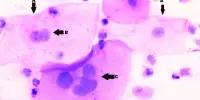A membrane protein is a protein molecule that is attached to or associated with the membrane of a cell or an organelle. They represent about a third of the proteins in living organisms. Examples of membrane proteins include ion channels, receptor proteins, and proteins that allow cells to connect to each other. Cell adhesion, energy transduction, signaling, cell recognition, and transport are just some of the important biological processes carried out by membrane proteins.
Proteins can associate with the membrane in one of three ways. Intrinsic or integral membrane proteins embedded in the hydrophobic region of the lipid bilayer. 20–30% of all genes in genomes code for membrane proteins. They are targets of over 50% of all modern medicinal drugs. Membrane proteins expose surfaces that are ideally suited for incorporation into, or binding to, membranes.
Function
They play crucial roles in all organisms, where they serve as, such as membrane receptors, ion channels, GPCR and various kinds of transport proteins. Membrane proteins perform a variety of functions vital to the survival of organisms:
- Junctions – Serve to connect and join two cells together. Membrane receptor proteins relay signals between the cell’s internal and external environments.
- Transport – Responsible for facilitated diffusion and active transport. Membrane transport proteins move molecules and ions across the membrane.
- Enzymes – Fixing to membranes localizes metabolic pathways. Membrane enzymes have many activities.
- Recognition – May function as markers for cellular identification. Cell adhesion molecules allow cells to identify each other and interact. For example, proteins involved in an immune response.
- Transduction – Function as receptors for peptide hormones.
Structure of Membrane Proteins
The amino acids of a membrane protein are localized according to polarity:
- Non-polar (hydrophobic) amino acids associate directly with the lipid bilayer
- Polar (hydrophilic) amino acids are located internally and face aqueous solutions
Transmembrane proteins typically adopt one of two tertiary structures:
- Single helices / helical bundles
- Beta barrels (common in channel proteins).
















